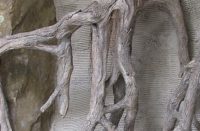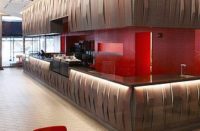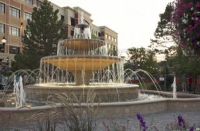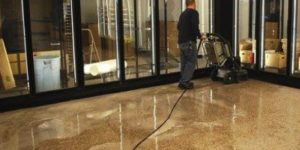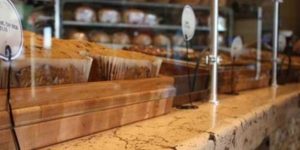When decorative concrete is mentioned, typically we’re referring to the booming market in flat concrete — floors, driveways, pool decks, even countertops. However, there are additional, more specialized niches in the decorative concrete arena: simulated rock formations, typically found in zoos, theme parks and resorts; and textured and colored concrete walls, bridges, tunnel portals and other vertical surfaces, found in dozens of applications.
Custom Rock International, a 31-year-old company based in St. Paul, Minnesota, is involved in all these kinds of applications and more. From humble beginnings in 1971 as a purveyor of colored and imprinted concrete designed to simulate stone or brick, Custom Rock has done projects throughout the US as well as the Carribean Islands, Saudi Arabia, and Asia. The company is now recognized as an industry leader in such areas as the manufacture of quality, high-definition rockwork castings.
 In the late 1970s, Custom Rock was given the opportunity to create an artificial rockwork project at the then-new Minnesota Zoo, recalls Paul Mooty, President of Custom Rock. “We were already in the business of creating simulated rock in flatwork, so this venture into creating simulated rock was a natural progression for us.” By the late 1980s, Custom Rock was asked to produce a stone texture mold for a poured-in-place concrete wall. “Given the company’s molding talents and expertise, this was, again, a logical progression for our business,” Mooty said. That project led to the development of a number of unique, patented methods of creating high-quality authentic stone textures on vertical surfaces in a seamless and non-repetitive fashion, he said.
In the late 1970s, Custom Rock was given the opportunity to create an artificial rockwork project at the then-new Minnesota Zoo, recalls Paul Mooty, President of Custom Rock. “We were already in the business of creating simulated rock in flatwork, so this venture into creating simulated rock was a natural progression for us.” By the late 1980s, Custom Rock was asked to produce a stone texture mold for a poured-in-place concrete wall. “Given the company’s molding talents and expertise, this was, again, a logical progression for our business,” Mooty said. That project led to the development of a number of unique, patented methods of creating high-quality authentic stone textures on vertical surfaces in a seamless and non-repetitive fashion, he said.
Durable Form Liners
A particularly successful part of Custom Rock’s business is the production and marketing of a broad line of form liners, including solid urethane DuraForm reusable liners. More than 30 different patterns, from weathered limestone and rustic barn wood to random cut stone and rustic ashlar, are available. In addition, in keeping with the company name, Custom Rock accepts the challenge to provide custom patterns as well.
 “When you combine our quality products with many years of experience in the custom molding of rock textures as well as other types of form liners including wood and brick, every job becomes a new experience that we as a company can grow and learn from,” said Jim Bohrer, Custom Rock’s Director of Wall Systems.
“When you combine our quality products with many years of experience in the custom molding of rock textures as well as other types of form liners including wood and brick, every job becomes a new experience that we as a company can grow and learn from,” said Jim Bohrer, Custom Rock’s Director of Wall Systems.
A recent successful project involved the production of wood grain form liners for the rebuilding of the damaged portion of The Pentagon in Washington D.C. The Department of Defense imposed very tight and challenging deadlines in order for the project to be completed by the one-year anniversary of the September 11th terrorist attacks. Although Custom Rock usually requires 3-6 weeks to create a custom form liner, the company worked extensively to manufacture 9,800 square feet of custom form liner in four weeks.
 “Our strengths in custom molding and the ability to produce samples quickly make projects like the Pentagon stay on schedule with the highest quality results,” said Bohrer.
“Our strengths in custom molding and the ability to produce samples quickly make projects like the Pentagon stay on schedule with the highest quality results,” said Bohrer.
Custom Rock has an impressive list of projects on which form liners were successfully used to duplicate natural stone structures: retaining walls and abutments in many park area throughout country; numerous wall projects at golf and country clubs; the killer whale exhibit at Sea World in California; a dam project in New Jersey; tunnel portals in Duluth, Minnesota; and many bridges across the United States.
In addition to the high quality results made possible through the use of Custom Rock form liners, they are cost effective for contractors as well, according to Bohrer. “Contractors recognize the cost savings in our form liners,” he noted. “Increasing labor costs, coupled with the costs associated with real stone, have increased the cost effectiveness of form liners, especially when the contractor chooses a standard pattern or uses a DuraForm highly reusable liner. The price per square foot becomes very economical because of the liner’s multiple use.”
 Concrete Rock Formations
Concrete Rock Formations
Custom Rock is a major player in the creation and installation of unique rock formations used in both indoor and outdoor artificial landscapes. Zoos, theme parks, museums, aquariums, casinos, resorts and even upscale residential property across the country have all been enhanced by Custom Rock products. At the Mall of America in Minnesota, the nation’s largest indoor amusement park called Camp Snoopy features 65,000 square feet of GFRC castings and 35,000 square feet of cast-in-place rockwork. One of the company’s most striking achievements can be seen at Grand Wailea Resort on the island of Maui in Hawaii, where a simulated 50-foot volcano and other volcanic rock formations adorn the complex of pools, grottos, caves and water slides.
 Custom Rock creates its rock formations using glass fiber reinforced concrete (GFRC). Once product has been delivered to the project site, individual rock panels are attached to a structural element. The panels are attached together with metal lath and a structural layer of concrete. Then a second and even a third layer of concrete (the textural coats) are placed over the structural layer. Finally, the newly installed rock feature receives a couple of coats of paint to match the actual color of the rock type being replicated.
Custom Rock creates its rock formations using glass fiber reinforced concrete (GFRC). Once product has been delivered to the project site, individual rock panels are attached to a structural element. The panels are attached together with metal lath and a structural layer of concrete. Then a second and even a third layer of concrete (the textural coats) are placed over the structural layer. Finally, the newly installed rock feature receives a couple of coats of paint to match the actual color of the rock type being replicated.
Installation involves several trades and a keen artistic eye, according to Bob Wallace, Director of Sales. “Typically, we use a number of trades for each rock installation. A couple members of each crew on every project must have a real artistic eye and hand to perform these specialized tasks, especially when embossing or coloring.”
Contractors who might be new to this type of decorative concrete application can rest assured that Custom Rock personnel can offer assistance throughout the duration of the project. “As a specialty concrete contractor, Custom Rock is able to take on the difficult, often near-impossible task of coordinating the manufacturing with the installation to assure the project’s quality and timetable aren’t compromised,” said Wallace. “Because we are a contractor ourselves, we understand the difficulties of the construction process and can help coordinate several issues within a project. From concept to completion, we help contractors be more efficient with specialty items.”
Contractors who purchase GFRC product from Custom Rock can request assistance in installation requirements and other special instruction on an as-needed basis. Custom Rock also offers a variety of services through its sales staff or through national distribution, and educates architects, engineers and contractors through on-site presentations, literature and shop drawings.
 Themed Construction and Architectural Paving
Themed Construction and Architectural Paving
Creating textured concrete surfaces that reinforce the vision of an owner, designer or architect is the specialty of Custom Rock’s Themed Construction services. From rainforests to ancient ruins, from lost cities to future worlds, Custom Rock has the services, experience and products that can make the imagined a reality. Notable projects range from facades and entryways for the chain of Rainforest Cafe restaurants to climbing walls at entertainment venues to interior mountain displays that replicate various wild habitats.
Custom Rock is still heavily involved in flatwork and architectural paving projects as well, offering a wide variety of colors, textures, stamps, stains, or the very latest in digital template imagery. Successful applications range from an elaborate pool deck at The Sahara in Las Vegas to a chemically stained retail showroom floor and a colored and stamped upscale residential driveway in Minnesota. Perhaps most notable is a unique plaza space outside the Cat House building at the Como Zoo in St. Paul. Silhouettes of various zoo animals were designed, digitized, enlarged and electronically cut out, and the end result looks like a huge animal jigsaw puzzle, which has proven to be a big hit with zoo visitors.
 The Future Looks Bright
The Future Looks Bright
The Custom Rock team sees nothing but good things ahead for the specialty concrete business. “I believe the demand for high quality form liners will continue to grow as architects, engineers contractors and the general public discover the difference between a quality project and one that doesn’t have the natural look of materials like stone or brick,” said Bohrer.
Concludes Wallace, “With new products being developed each year, a greater appreciation by design professionals of the many uses, and increased acceptance by contractors, the future looks bright for the specialty concrete business in general, and Custom Rock in particular.”
